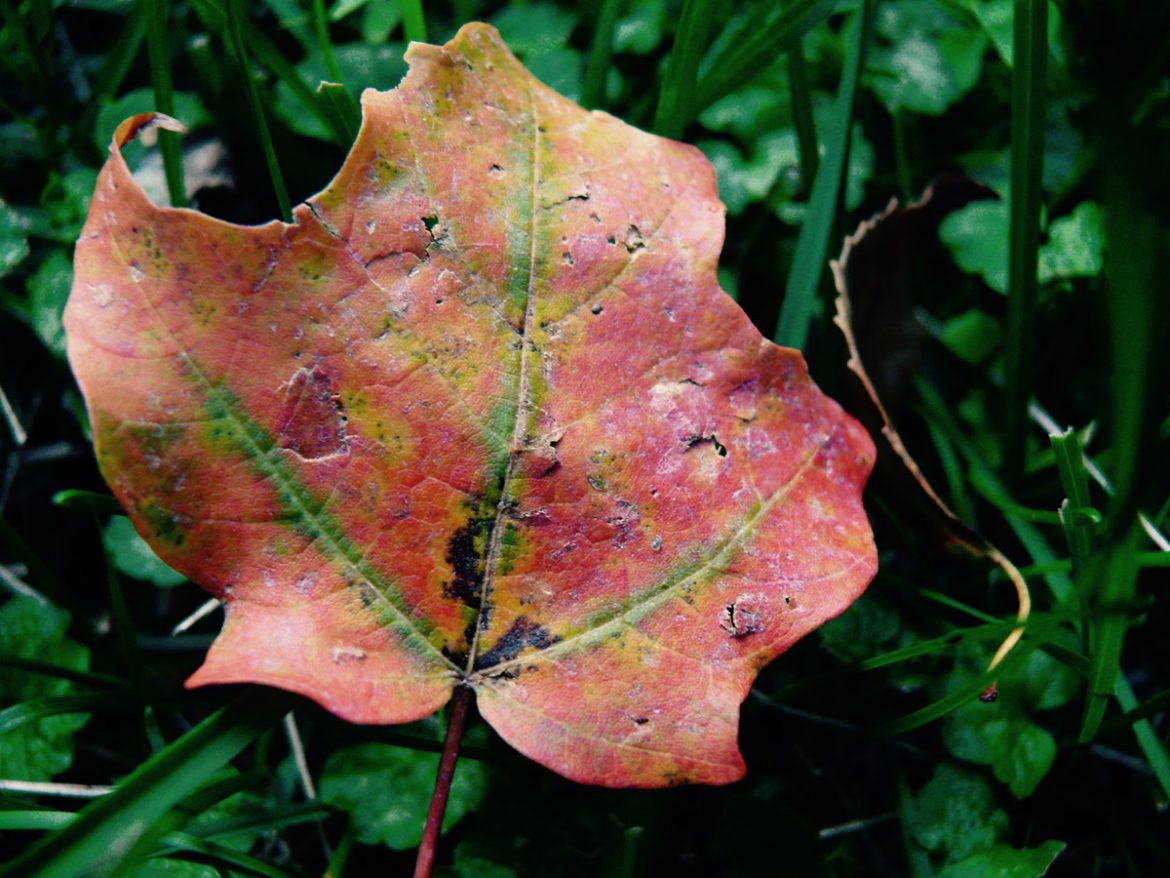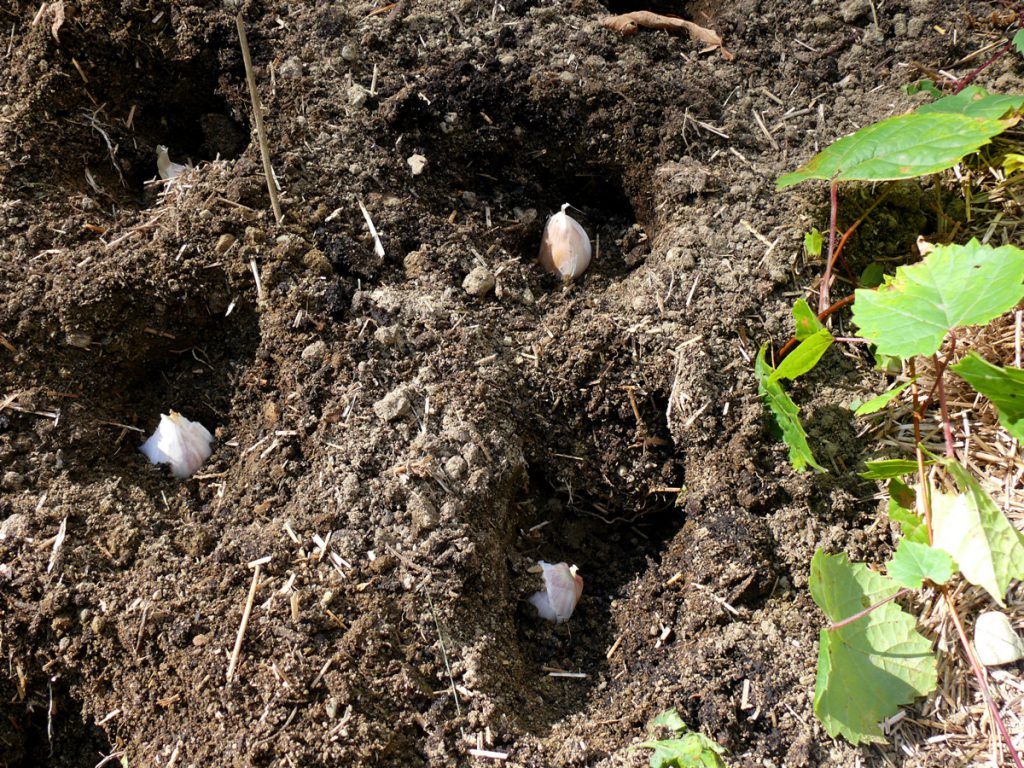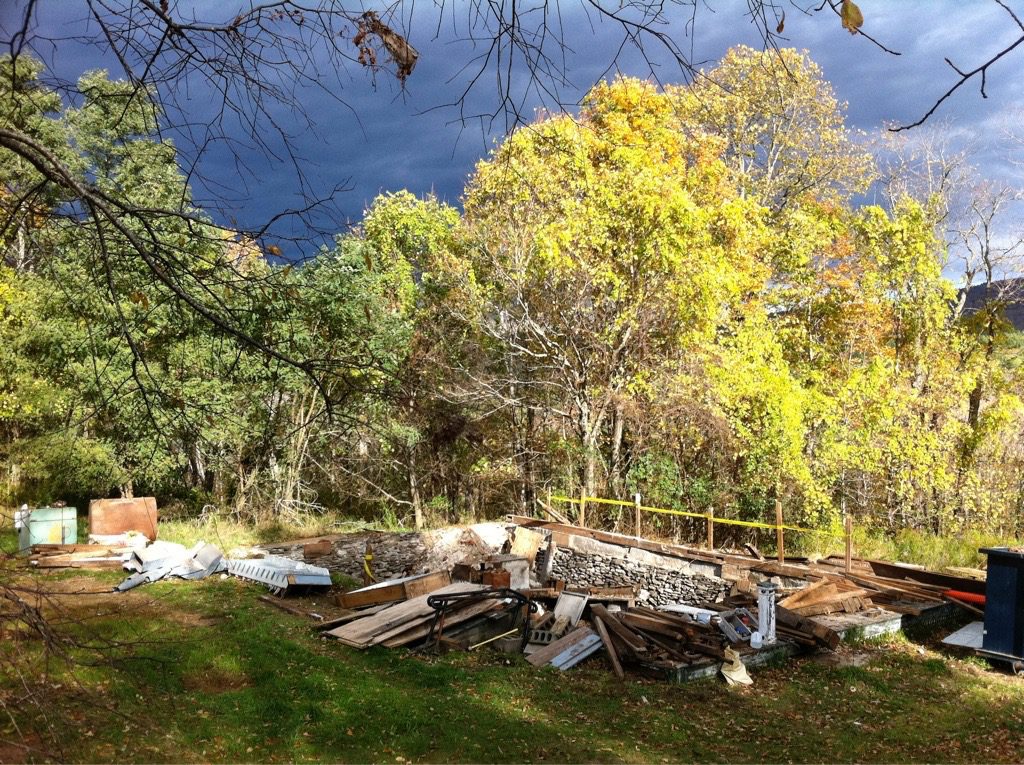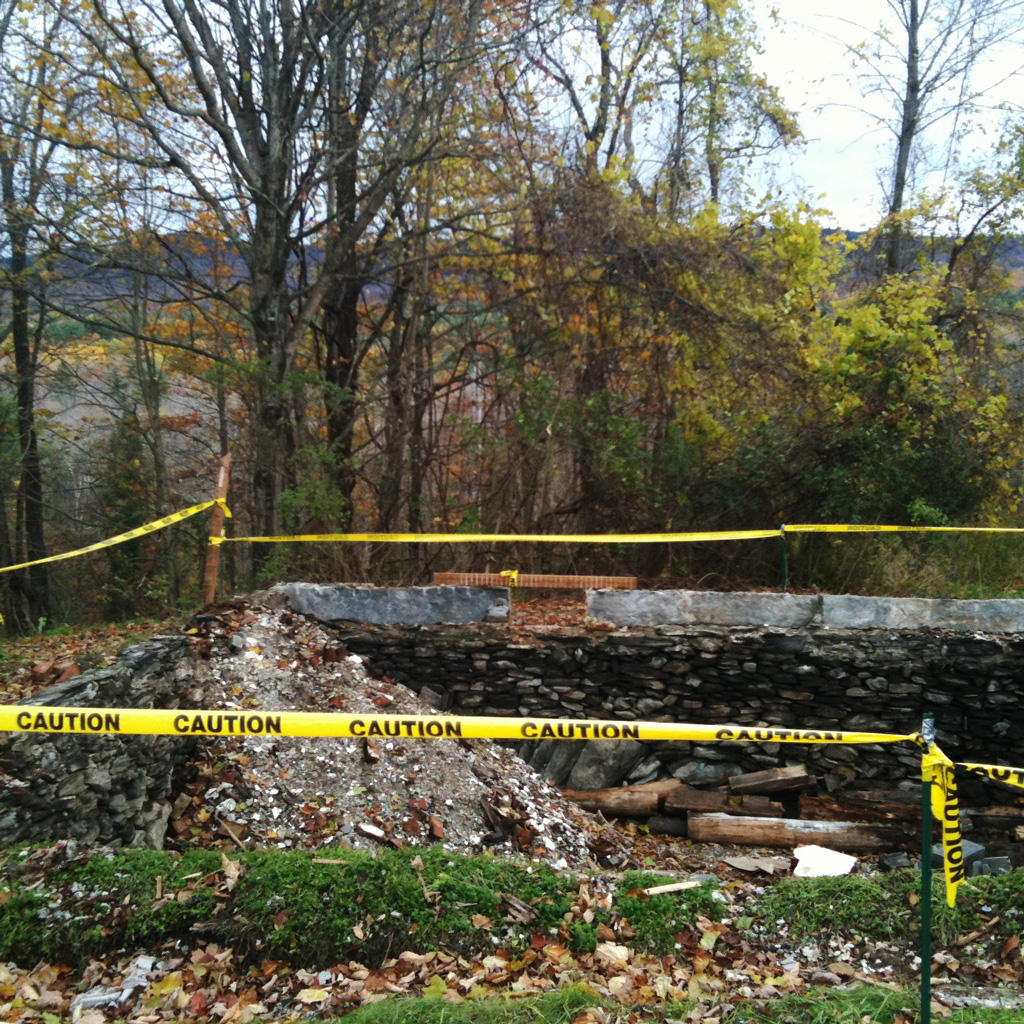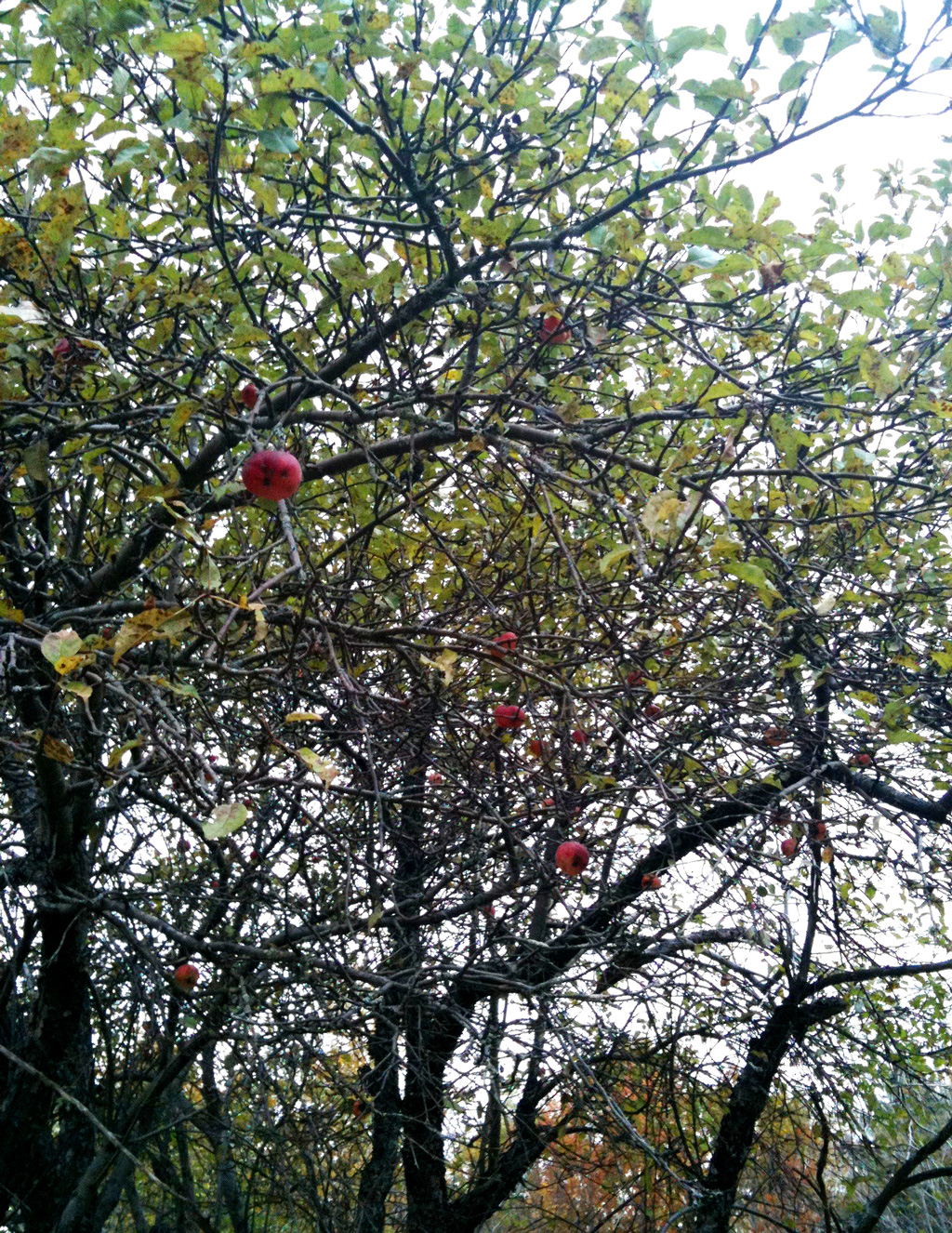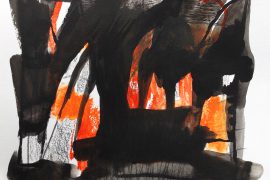I planted my garlic last week. It was a good day for planting, sunny and mild. I punched holes in the earth, then set a clove in each hole, root down, point up. I sowed perhaps thirty or forty square feet of it, then raked the soil level and tamped it lightly, finally spreading straw mulch over the bed, insulating against the long winter. This coming spring, perhaps in late March or early April, the bulbs will awaken and their green tips will pierce first the soil, then the mulch, then the last rime of winter, tipping forward toward the light, reaching.
The garlic planting was an annual ritual I resumed just last year. I’d been without a vegetable garden for nearly seven years, but finally and at last, once our house remodeling project was mostly complete, I was able to carve open a space in our new yard for a small plot. The timing of the garlic planting is sensitive. Plant too early and the bulbs will break before winter and be killed. Plant too late and one must chop at frozen soil. It was a joy to do it, and a relief to get it done at the time it must be done. Vegetable gardening makes its own exigencies, to which I happily yield.
We’d had our first seasonal frost the night before that planting, very late for a first frost here. That morning the lawn was laced with a misty haze of crystals that lay along each green blade of grass and each golden curl of fallen leaf. As the day rose, the sky opened to a thin, high blue, the air lacking all substance, hollow now that the heat has flown on and away. Fall as the absence of summer.
It was a long season. Leaf-out occurred this year mid-April, nearly a full month early. By late August the trees were spent and exhausted and starting to show signs of wear. By now the trees were down to their lingerie, and what leaves remained were the golds and russet browns and deep chartreuse yellows of late season. The season’s chemistry is always surprising, elusive and mysterious. There were few bright reds and oranges this year; some autumns go out in a blaze while others wither and retreat quietly. By November, though, it’s all brown anyway. The vegetable garden mostly escaped damage from our first frost, snugged up as it is against the south face of the house, with its broad stone retaining walls retaining not just earth but also heat, re-radiating it all night long like a warm exhale. So the tomatoes persist, the eggplants persist, and even the tender basil looks only a little piqued.
The garden will carry on a while yet, just a little while, though it has mostly ceased to yield, the plants now playing through their drama in slow motion. The flowers still bud but open slowly, and the bees come lazily, often falling quiescent and remaining on the flowers well into dusk, sleepy and drunken with cold, forgetting their home, or forsaking it in favor of this more delicate repose. Now fertilized, the fruits of the garden form and drop like tiny green pendants from their sepals, but they lengthen and flesh out languorously. There are tiny slender beans, tiny spheres of cherry tomatoes. They will not ripen, yet the plants keep trying, keep to their purpose of sequestering their energy deep into the seeds of their fruits, their one chance at immortality. The sunlight is dim and wan, and it turns on late and goes off early. It’s not merely the cold, but also the shortening arc-length of day that calls the play, finally, to a close.
It’s a season of movement, of moving on. A flurry of dark-eyed juncos has animated the yard the last few days, flickering between the scrubby trees and unkempt lawn. They are on the move, headed south, feeding themselves. They seem the very essence of aliveness. It has been raining, sometimes in torrents, and I waded out to spread seed for the birds in the thick, wet grass. Their dark gray bodies move and peck in little starts, and in the grass they look like fat gray voles as they rummage, head down, for seed. Then suddenly they all startle and alight, the adults’ white tail feathers flashing like pinwheels as they take to the trees, the air suddenly alive with birds, leaves, rain. This thrills and torments my indoor cat, who scuttles between windows for the most tantalizing view, her body frozen, her gold eyes fixed. Only her tail belies the exquisite anxiety of her wanting.
All of nature is on the move, alive while slowly dying.
Credit: M. Yacavone
I visited the Rennie Farm this week. It was time I went to see it again at last, and to see what it felt like to be there. The day was blustery and raw, a damp, windswept gray with a smattering of rain. A few migrating robins chased each other across the open yard, moving swiftly from the trees at the road’s margin to the scrub where the chicken coop once stood, clucking their chirrup alarm note, calling to each other: Where are you? I’m here. Stay together now, stay together, we’ve still got a long way to go. They flew in waves across the gaping cellar hole, a house’s roots open to the sky, its walls of stones and dirt now exposed and crumbling. At one corner lay a heap of plaster and masonry, in the center the toppled column of chimney. Nearby was a dumpster, and around the yard lay salvaged bricks and beams, a set of shutters, peeling doors. And here was the stone stoop, a broad, smooth slab of granite four feet wide and three feet deep. The hearth may be cold, but the threshold remains.The workers had staked yellow flagging tape around the perimeter of the cellar hole, clean and bright and shouting: CAUTION CAUTION CAUTION. At first I obediently stood outside the tape, peering gingerly into the rubble. But wait—I lived here, I thought, stepping over the flagging. It can’t hurt me. I am no stranger. This place was mine.
I stood where the porch had once been, the rusted nails and chips of ancient paint and shards of broken glass making a carpet over the wet earth. The foundation looked small, so small to me. How could such a big house—what had seemed like such a fine, big house—have had such small feet? How could all that history—my history—have fit into this tiny square of earth?
But what history, really? I didn’t grow up here. This wasn’t a family home, its history wasn’t the history of my parents and forebears. I’d spent a mere three years here just after college, cohabitating with a few housemates, unrelated. So why now did I feel such waves of longing and nostalgia, of remembrance and loss, of deep privation at the sight of this farm undone?
Dartmouth College had bought a 250-acre property from a farmer named Rennie in the 1950s. They intended to plant their “women’s campus” there, but of course that never happened. Nonetheless, the college held onto the old property, haying it each summer to claim an agricultural tax break, and leasing it to college staff for nominal rent. When I lived there in the early 1990s, the rent for the five-bedroom farmhouse was four hundred dollars a month.
The place was an antique, built in the mid 1800s. Set apart from it was a big hay barn, probably built contemporaneously. Over time the barn had become hollow and reedy, habitat for doves and starlings and bats and myriad rodents, and each spring it served as a resonating chamber for the flicker who woke us early as he rat-a-tat-tatted his territorial proclamation on its rusting tin roof. There was also a small chicken coop, perhaps of only slightly more recent vintage, and along one side of the big dusty driveway a 3-bay cinderblock garage with a dirt floor, an aesthetic indiscretion added sometime in the last half-century.
During the period I lived there the college more or less kept the place up, painting the exterior clapboards and replacing the fire-hazardous post and tube wiring with a modern electrical system. Evidently, all other upgrades were thoroughly discretionary. And where might one begin, anyway? The walls and attic were barely insulated. The cellar had a dirt floor, and its stone walls emitted a rank, penetrating dampness. I didn’t know anything about dry rot at the time, though it must have been a considerable threat to the house’s timber framing. On the other hand, the cellar’s connection to the earth kept it a near-constant fifty-five degrees in both summer and winter, making it an outstanding storage cellar for our root crops and jarred produce. I’ll likely never have a more felicitous place to store a year’s worth of carrots. The farmhouse’s windows were all original, and although metal storms and screens had been added at some point much later, there were chinks in the windows’ framing and a very leaky sill, so the structure was a strainer for the winter winds, requiring us each fall to undertake the seasonal task of temporary weatherproofing. In the summer the ground floor of the building remained reasonably cool, while the upper floors baked and steamed. The place was, effectively, one with its surroundings, a thin membrane between us and the rest of New Hampshire. It wasn’t as much house as organism, and in that sense we could rightly, if somewhat perversely, have considered ourselves parasites on the host. We used it for our purposes as gently as possible, because we needed it to remain alive.
It was made explicit to each new occupant that residence at the Rennie Farm required one to participate in the growing, processing, preserving, and cooking of food; the preparation of firewood (nine cords) to heat us through the winter; the winterization activities in the fall and the fluffing and cleanout in the spring; and the parsimonious use of all resources: fuel oil, electricity, water. I’d grown up in a middle-class suburban environment in a home that fretted over little of the above, but I’d recently become a vegetarian, taught myself to cook, and started learning about what some call “right livelihood” (and what generations before us called just plain livelihood); namely the kind of liberal conservatism that views each individual as an entity in a very fragile ecological system, and that survival of the whole requires commitment to limiting one’s consumption and waste. In other words: grow or make or borrow what you can, buy only what you can’t, and use it all frugally. Ideologically I was more than willing, and I didn’t have much money anyway. But what did I know? I knew nothing.
My housemates P. and B., a couple, both worked in the college’s biology department full-time, but they were also—and maybe primarily—homesteaders here, scratching a working farm into the thin New Hampshire soil. During grad school, P. had started gardening, mostly from impoverished necessity, and had taken to it with a biological scientist’s zeal. B. had grown up gardening; growing and preserving food was just what one did. Together they husbanded chickens in the raggedy coop so we always had fresh eggs: blue-green from the Araucana hens, and brown from the Barred Rocks and Orpingtons. There were many more eggs in the summer than in winter, when the day’s short length told the chickens to slow down. The feeble electric bulb we ran on a timer, clicking out the darkness at 5:30 a.m. and keeping it at bay until 9:00 p.m., was only moderately persuasive to the hens. My housemates had also put in about 2,500 square feet of vegetable garden, planting summer produce—tomatoes, peas, lettuce, beans, carrots, and much more—as well as squashes and shell beans and dent corn for flour to carry the household through the winter.
The gardens were an ambition that required almost constant attention. In February the seed catalogs arrived. By March the seedlings had been started under fluorescent lights rigged up in the living room. By April the first planting began—starting with the peas, usually—and by July the gardens were going full tilt. Frost usually closed us down by late September, but by then it was time to plant the garlic, and clean-up lingered well into October, to say nothing of the disposition of hundreds of pounds of produce into jars, freezer bags, and storage bins.
One does not need a book or class to learn to garden; one need only spend countless hours in apprenticeship, brandishing a hoe and dirtying one’s knees alongside a knowledgeable other. Working alongside P. and B., I learned that I liked gardening—loved it, in fact. I loved its praxis: the planting, weeding, picking, and eating was not a chore, but an activity that yielded, was satisfying. I loved its poetics: the notion of pulling nourishment from the landscape, of becoming part of the energy cycle of the land, of working against the entropy gradient to create food out of earth, an act that seems at once utterly mundane and exquisitely improbable. Along the way I picked up some biology, botany, chemistry, genetics. I got pretty good at figuring out what the plants needed. I learned to tend the soil, not the plant. I got physically strong. I eventually moved on to restoring the Rennies’ old flower beds, long overgrown, spending hundreds of hours recovering these ornamental gardens from decades of inattention, peeling back the sod and digging out the burdock to reveal the gardens’ bones, to find what might remain, and to make room for the cast-offs and divisions I was able to snag from friends’ gardens. Time in the ornamental beds was an indulgence when there were arguably more critical garden matters to attend, but my artistic compulsion drove me to it, and I was almost never happier.
The Rennie Farm has been unoccupied for the last decade—I know because I now live only about four miles from the property. Over the last month I’d noticed a demolition team starting to take the place down. Piece by piece, they carried away the porch, the clapboards and roof tin, the sheathing, the framing, the plaster, the fixtures. Although I drove by a number of times, I couldn’t bring myself to stop for a look, but I did drop a note to a few friends who had also lived there, letting them know of its imminent demise. One paid the place a visit and sent me a picture. It was an eerie photo. The scene had an unearthly quality, the trees lit by the late afternoon sun, dazzling yellow-green against a darkening eastern sky. The wrack of the demolition mid-process was strewn about the property: a staircase, the oil tank, sundry beams, a metal sink. The cellar hole was already exposed, a place where a house once stood. It had been nineteen years since I lived there—or even set foot on the place that had once been so important to me. It had always been enough simply to know it was still there, to be reminded whenever I drove by. But now it was going, and almost gone. It was time for me to visit, although I knew that visiting at the dying end of the year, the season of moving on, was perhaps the bitterest, tenderest moment to do so. I turned from the cellar hole, stepping back over the yellow CAUTION tape and thrusting my hands into my pockets against the raw October chill. I would look around a bit.The flower gardens, my flower gardens, were a wild ruin. The stone wall garden, another that edged the driveway, and a third that was our view from the kitchen—all were now a riot of weeds, a tangle of grasses and burdock and vetch. Their boundaries were ambiguous, and unless one knew exactly where they had been, or pointed an experienced gardener’s eye at the evident tangle, one would never guess that this landscape had ever been anything but weeds. The tansy I’d so tenderly transplanted had, in the intervening years, swallowed up its brethren and marched inexorably across its bed, breaching the border and occupying what had once been lawn. There was no remaining evidence of its neighbors, the Oriental poppy, the Opium poppy, the lilies and irises, the ferns, the Echinacea. The driveway garden was so overgrown it was nearly impossible to locate the massive granite curbs that had once so clearly defined its perimeter, but here at least I spied a sprig of variegated spurge and two meager stalks of phlox, its tiny pink blossoms luminous survivors waving a flag for domesticity.
I walked up the farm road, rising into the property. The dooryard gravel petered out, and the roadbed turned into two matted parallel ruts, churned and brown from the week’s rains. The track had clearly seen recent traffic, perhaps from a late-season haying in the upper fields. Here was the blackberry patch, once so tightly bristled, now spilling down to the road’s edge and across the field to the neighbor’s land. Here was the spot where the barn had stood; that had been taken down years ago, and what remained was merely a smooth, unscarred swath of green. Here was the chicken coop, and here the butternut tree where that one crazy hen would sometimes roost. Here was the spot in the track where we found the coyote print the day that crazy hen disappeared in broad daylight: scratching in the dirt one minute, then gone without a sound.
I continued up the road, following the track past the meadow now reclaimed. All evidence of our huge vegetable garden here was gone. The massive plot we had tended so fixedly, the garden that had produced vegetables for six for a year, the garden where I had learned to garden, was just hayed pasture now, punctuated by rough, chopped stocks of milkweed stems bent and browning in the October chill—milkweed we had fought to keep at bay, now stoically triumphant in the wan haze of fall. The garden was now a garden only in mind and in hand, and in the memories these both keep.
And above, at last, to the orchard. There used to be six ancient trees, I think, but now just four remain. They have changed just a little in twenty years, as apple trees do—perhaps a bit more gnarled below and more lanky above. Yet in their branches that day, glowing against the cold gray sky, were apples, bright and sweet and tart and round, ready to be pressed to cider, to be cut into a pie, to come inside and be food once again. I picked one, feeling its smooth, cold skin against my hand, and put it into my pocket. Here is entropy’s demise, I thought, where the end meets the beginning. The farm is dead; long live the farm.
I wasn’t always happy here, but I was mostly happy. Or perhaps it’s better to say that the place itself was a happiness, and any unhappiness I felt living here—and learning how to live here—was deeply interior. This was the place I first felt truly at home. But a home lasts only as long as there are occupants to keep it, to safeguard the energy of its place, to keep noticing. An empty house doesn’t live for long; it needs to be constantly made and remade by the someones who reside there: to fix the windows, to plant the garden, to believe that there will be a next year, and a next, and then to tilt forward toward it, hoping.
Excerpted from Making it Home, a book-length manuscript submitted in partial completion of the degree of Master of Arts in Liberal Studies/Creative Writing, Dartmouth College, April 2011.

